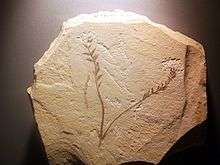Archaefructus
| Archaefructus Temporal range: Early Cretaceous | |
|---|---|
 | |
| Archaefructus liaoningensis - a photograph of a facsimile of the fossil | |
| Scientific classification | |
| Kingdom: | Plantae |
| (unranked): | Angiosperms |
| Class: | incertae sedis |
| Family: | Archaefructaceae Sun, Ji, Dilcher, Zheng, Nixon & Wang |
| Genus: | Archaefructus Sun, Dilcher, Zheng & Zhou |
| Species | |
|
Archaefructus eoflora | |
Archaefructus is an extinct genus of herbaceous aquatic seed plants with 3 known species. Fossil material assigned to this genus originates from the Yixian Formation in northeastern China, originally dated as late Jurassic but now thought to be approximately 125 million years old, or early Cretaceous in age. Even with its revised age, Archaefructus has been proposed to be one of the earliest known genera of flowering plants.
Because of its age, lack of sepals and petals, and the fact that its reproductive organs ( carpels and stamens ), are produced on an elongate stem rather than condensed into a flower as in modern angiosperms, Archaefructaceae has been proposed as a new basal angiosperm family.[1] An alternative interpretation of the same fossil, however, interprets the elongate stem as an inflorescence rather than a flower, with staminate (male) flowers below and pistillate (female) flower above.[2] The discovery of Archaefructus eoflora[3] supports this interpretation, because a bisexual flower is present in the region between staminate and pistillate organs. If this interpretation is correct, Archaefructus may not be basal within angiosperms, rather it may be close to the Nymphaeales or the basal eudicots.
References
- ↑ Sun, G., Q. Ji, D.L. Dilcher, S. Zheng, K.C. Nixon & X. Wang 2002. Archaefructaceae, a New Basal Angiosperm Family. Science 296(5569): 899–904.
- ↑ Friis, E.M., J.A. Doyle, P.K. Endress & Q. Leng 2003. Archaefructus – Angiosperm precursor or specialized early angiosperm? Trends in Plant Sciences 8: 369–373.
- ↑ Ji, Q., H. Li, L.M. Bowe, Y. Liu & D.W. Taylor 2004. "Early Cretaceous Archaefructus eoflora sp. nov. with Bisexual Flowers from Beipiao, Western Liaoning, China." (PDF). (3.11 MiB) Acta Geologica Sinica 78(4): 883–896.